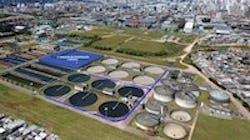A Treatment Plant Fit for São Paulo
Overview
The state of São Paulo is the world’s seventh most populous urban area and is considered the economic, financial and technical hub of Brazil. The region contains nearly one-fourth of the country’s population but less than 2% of Brazil’s water.
The state government, recognizing the importance of safeguarding drinking water for the regions inhabitants, recently issued new regulations to restrict the industrial use of potable water, forcing factories to look for ways to reuse their wastewater or obtain recycled water from another source.
The Aquapolo Ambiental water reuse venture was created to address these new regulations. Aquapolo is the largest water reuse project in the Southern Hemisphere and the fifth largest of its kind in the world.
Upon completion, this groundbreaking facility will free up enough drinking water to continuously supply a population of 350,000 inhabitants, with the potential capacity to reach 600,000.
The Challenge
To build a treatment plant capable of meeting São Paulo’s pressing demand for industrial reuse water.
The Solution
Koch Membrane Systems (KMS) conducted a comprehensive feasibility study to identify the most cost-effective strategy to upgrade the existing plant infrastructure and concluded that membrane bioreactor (MBR) technology with a Tertiary Membrane Bioreactor (TMBR) system was the best solution for the new facility.
To validate the TMBR approach, a one-year pilot study was conducted. A standard MBR pilot plant was used to confirm the design parameters, optimize the system operation and evaluate operating costs. A standard RO pilot was also used to simulate the RO design concept of the proposed full-scale system for 200 L/s feed water. The final water quality for reuse was achieved by blending the TMBR and RO permeates. Together, both phases of the pilot study demonstrated a viable full-scale solution for water reuse under difficult operational conditions.
KMS was chosen by Aquapolo for its superior technical support and biological design, the availability of MBR and RO pilot plants, its vast experience with water-recycling projects and ability to meet an extremely accelerated delivery schedule.
“Koch Membrane Systems’ willingness to work with us as our technological partner was a key factor in our decision to award them the contract,” said Emyr Diniz Costa, senior project director at Odebrecht. “They offered a comprehensive engineering solution and dedicated extensive pre-engineering man hours to produce the most reliable design and state-of-the-art technology for our project. The availability of a pilot plant convinced us their solution was the best one.”
The Aquapolo facility will employ KMS PURON MBR technology as well as MegaMagnum reverse osmosis (RO) membranes. KMS will also supply the system design and controls and after-market support and service.
The Treatment Plant
In total, the Aquapolo project will encompass the construction of a new pretreatment step, installation of a chemical-dosing system and the construction of a 700 L/s TMBR utilizing 94,500 sq meters of membrane area. The TMBR offers lower operating costs, lower process risk, greenfield design and negligible interaction with current plant operations and equipment.
The TMBR is a polishing MBR process. It will treat water coming from the existing secondary clarifiers and further treat it in a newly built biological step using membranes as the final separation process. Some of the TMBR effluent will be further treated by RO membranes to meet conductivity goals for water reuse.
The TMBR pilot demonstrated that the submerged membranes benefited from the optimized biological system. Average flux rates of >25 L/m2h were achieved and daily maintenance cleaning was found to enhance the UF performance. Recovery cleaning returned the UF membrane to the original process permeability.
A standard RO pilot was also used to simulate the RO design concept of the proposed full-scale system for 200 L/s feed water. The pilot trials were set up in three well-defined phases: a simple batch mode, a modified batch mode and a continuous mode. The RO system was able to produce an excellent water quality.
Construction started in April 2010; the water treatment portion of the project is following an aggressive schedule for startup in November 2011.
Product Overview
KMS supplied 63 PURON PSH1500 membrane modules and two MegaMagnum MM9 RO units for the new Aquapolo facility.
PURON submerged-membrane modules produce high-quality effluent that meets stringent water reuse and recycling requirements while significantly reducing the treatment system footprint. PURON modules are energy-efficient, with the lowest energy demand of all commercially available MBR modules.
The system is easy to operate, with features that are designed to provide significantly lower life-cycle costs, including a single header design that provides better solids management in the module, braided fibers to reduce the risk of fiber breakage and high effective air scouring method that virtually eliminates sludging.
An important advantage of the patented PURON module is the use of a single header with reinforced hollow fibers that are fixed only at the bottom. The sealed upper end of the fiber is allowed to float freely. The free floating top design eliminates the build-up of hair and fibrous materials that typically clog the upper ends of membrane fibers in MBR module designs that employ both top and bottom headers.
In addition to the PURON modules, the large diameter MegaMagnum RO elements will complete the custom-designed system. Each of the MM9 systems chosen for Aquapolo has a flow capacity of 1.7 million gal per day and 6,500 cu meters per day.
